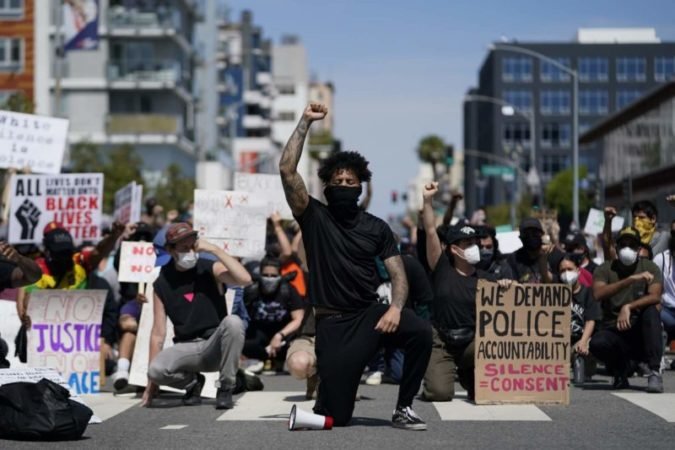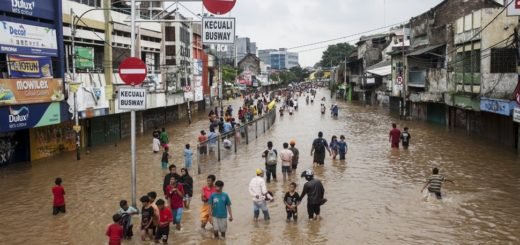Dual challenge for the US: Protests and the pandemic

Covid-19 is proving to be a catastrophe both for human lives and the economies. With the persistent spread of the virus and no prior experience of the present imbroglio, countries in the world have resorted to the measures of lockdown and the practice of physical distancing.
A total of more than 7 million cases have been recorded worldwide, with around 397k succumbed to the disease. In the US alone, the tally of casualties has crossed 100k with the University of Washington researchers estimated on Monday that 1,45,728 people could die of Covid-19 by August 2020.
The Uprising
However, one death in Minneapolis, Minnesota, has led to a huge uproar and resistance in the United States of America last week. George Perry Floyd Jr., an African-American man was killed brutally by the police officials in Minneapolis, Minnesota on May 25th. Since his death, about 140 cities in all 50 states throughout the US have seen protests and demonstrations in stimulus to the killing. People have taken to the streets since then and have been asserting their opinions against the thousands of year-old practice of discrimination and persecution based on race, colour, etc. and demanding justice for Floyd, who is survived by his wife and his daughter, and the overall racial equality in the country.

However, a certain section of the protestors masquerading as “the forerunners of change” have also been seen indulging in violent activities and have been pillaging the shops and destroying and burning the neighbourhoods, public properties, and residential localities. According to them, they are showing their dissent, their resentment against the regime. It is that which they can see. And that which they can’t see is the locality where they’ve set fire also belongs to the very same people for whom they are on the streets in the first place.
Administration in some of the states is being quite autocratic in its response to the protests. Some people are also trying to politicize the matter for the upcoming presidential elections. Rather not delving deep into the political motivations of the incidents of violence or counter-response of the forces, talking about the economic implications of the demonstrations would-be the prime focus here, assuming political forces ceteris paribus.
However, the two are inextricably intertwined.

The other side
J.M. Keynes and post Keynesians/neo-Ricardians have claimed wars or earthquakes might not be that bad for the economy. Nobel Laureate economist and the New York Times columnist Paul Krugman while writing about 9/11 claimed, “the direct economic impact of the attacks will probably not be that bad.”
Similarly, it can be seen on the internet people supporting the current actions of violence not that bad from an economic point of view. I’m not sure if many people are claiming this outright, but some have suggested(probably the ideological ancestors of Krugman) that burning targets (or otherwise destroying property) aren’t as bad as it seems. Many people cite the example of post world war 2 prosperity to corroborate the claim. It’s quite evident though, the US mobilized its economy for world war after Pearl Harbor, and it did curb the great depression. But does a correlation between two variables always mean causation? Do we get better off if the government invests in an infrastructural project or the economic prosperity is greater when a terrorist organization bombs a place?
The story given below would provide us with the details and intricacies of one of the most persistent parables in economics.
Imagine a shopkeeper with a shop that has glass windows on the forefront. A notorious kid passing through it, lifts a stone and throws it towards the windows. Baam!!! The windowpane got shattered. The Kid ran leaving the shopkeeper and around 20 people witness to the incident and one lanky lad out of them came forward and exclaimed, “look on the brighter side, pal”.
The above story is the premise of an essay by 19th-century french theorist and economist Frédéric Bastiat in which he talks about the very famous parable in Economics- the broken window fallacy- in a pamphlet entitled that which is seen and that which is not seen.
The pamphlet by Bastiat published in 1850, however, got popularized around a century later when another economist Henry Hazlitt mentioned it in his important book called ‘Economics in one lesson’.

Is breaking that bad?
Now coming back to the story of our shopkeeper who is upset about the broken window. The suggestion being made by a lanky fellow was, “look on the brighter side”. By the brighter side, he meant that the amount spent on buying the new glasses for the window would become the income of the glazier. The same glazier could then spend the amount on buying the shoes, or drink wine or watch movies, or invest it, or whatever he likes to do. This would create jobs in the economy and hence would generate income for other people and those people are gonna get richer just because some notorious kid threw a rock at the glass. Basically what it is implying is that “Destruction could eventually lead to prosperity”.
However, it is just one side of the story. We are taking into account the factors that we can see but not the ones which cannot be seen.
The Unseen
According to Bastiat, the amount spent by the shopkeeper would have been used somewhere else if the shopkeeper hadn’t had to pay for replacing the window. He could have used it for buying shoes for his son, or buying raw materials for his shop, or he could have lent it to someone who may have started his new business and provided a job to others. And the world still might have its window intact.
Bastiat in his original paper says, “It is not seen that as our shopkeeper has spent some francs upon one thing, he cannot spend them upon another. It is not seen that if he had not had a window to replace, he would, perhaps, have replaced his old shoes, or added another book to his library. In short, he would have employed his francs in some way, which this accident has prevented. As Bastiat points out, though, while the cost of replacing the pane is seen, other things aren’t. To bear the cost of replacing the window the shopkeeper could increase the price of his product. The customer would have to spend more to buy his product, making them worse off.
Similarly, more broken windows increase the demand for glasses which means higher prices. A man building a house would have to spend more. This shows that one must look not only at the immediate effects of action but at the long term effects & the effects prevented. The main point that Bastiat made is that when we generate income through destruction we are not adding anything of value to the economy, even though we are providing jobs to the people, but we are merely busy in replacing/repairing something that has always been there.
So, it is not destruction which leads to prosperity but production.
It is installing new window panes which guarantee prosperity, not breaking the ones that already existed.
Bastiat’s parable about the ignorance of unseen elements is just not limited to individual households, shopkeepers, businessmen but it is widely applicable and resonates with the economic implications of disorders in the system like the current unrest and cases of violence and pillaging in the United States.

Protests and the Pandemic
An Oklahoma State football player tweeted that he has tested positive for COVID-19 after attending a protest in Tulsa even after being well protective. In Columbus, Ohio, the first case of a protester testing positive for COVID-19 was announced on June 3. The United States has been the worst affected by the Coronavirus. Now with people coming out on the streets, abandoning the physical distance, standing shoulder to shoulder with each other, some with masks and some without masks, chances are very high that the situation could get out of hand once again.
The World Health Organisation(WHO) took the time at its daily conference to address its concern on the issue. “WHO fully supports equality and the global movement against racism. We reject discrimination of all kinds,” said WHO director-general Tedros Adhanom Ghebreyesus on June 8. He also advised people to maintain a safe distance from others — and to stay home if they are sick.
According to modelers, it’s difficult to assess the impact of protests on coronavirus infections. Since Covid-19 has an incubation period of 12 to 14 days, the real impact would be visible in the next couple of weeks.
Meanwhile, protests are expected to continue in the weeks ahead.
REFERENCES
- https://www.nytimes.com/2001/09/14/opinion/reckonings-after-the-horror.html
- https://www.arabnews.com/node/1686276/world
- https://www.youtube.com/watch?v=erJEaFpS9ls&t=7s
- https://www.investopedia.com/ask/answers/08/broken-window-fallacy.asp#:~:text=The%20broken%20window%20fallacy%20is,economic%20consequences%20for%20many%20others.
- http://bastiat.org/en/twisatwins.html


















